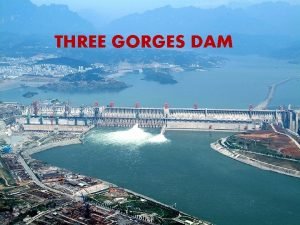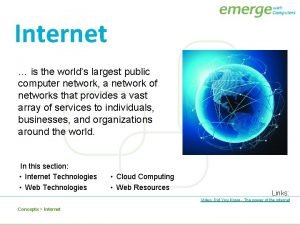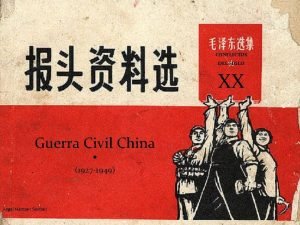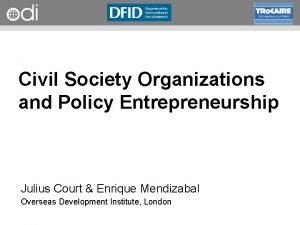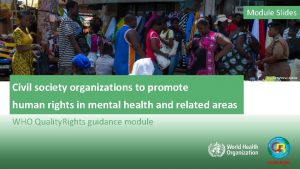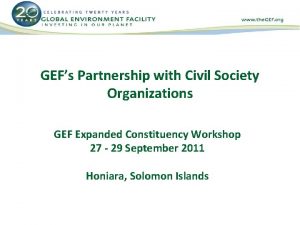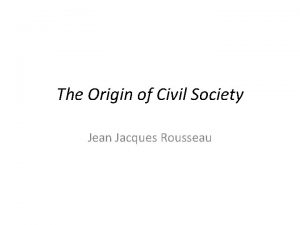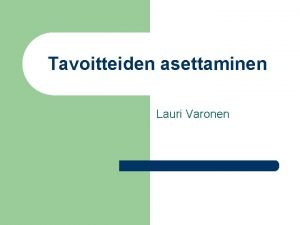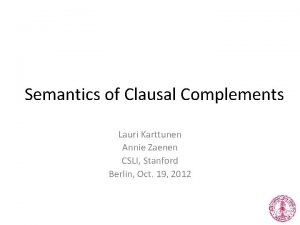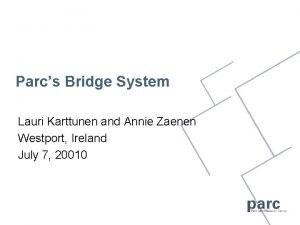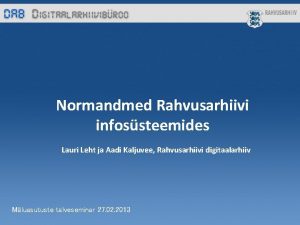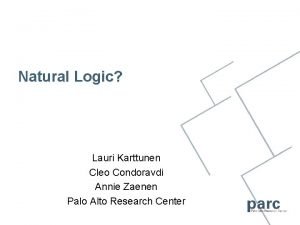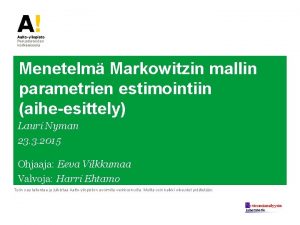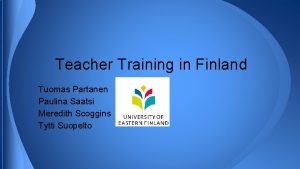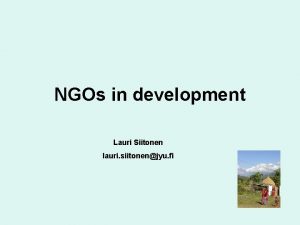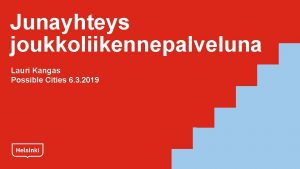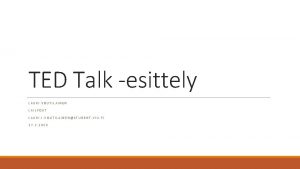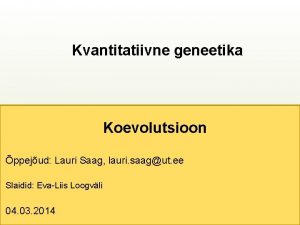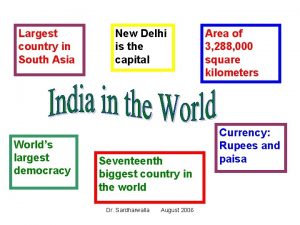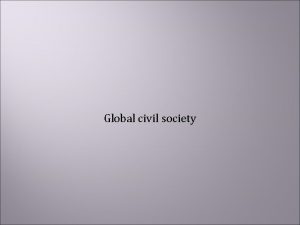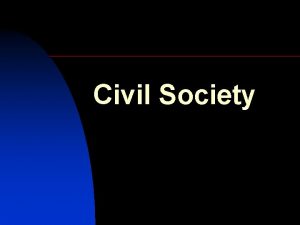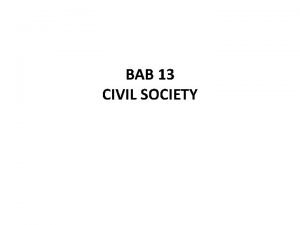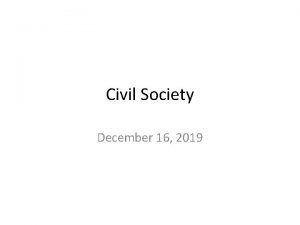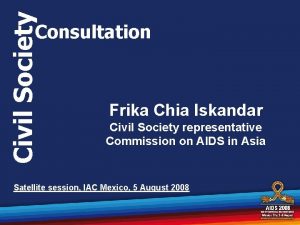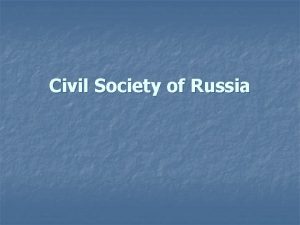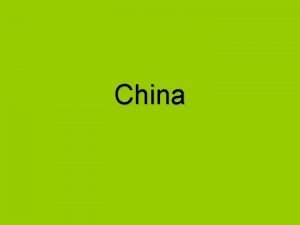CHINA WORLDS LARGEST CIVIL SOCIETY Lauri Paltemaa Centre







































- Slides: 39

CHINA – WORLD’S LARGEST CIVIL SOCIETY? Lauri Paltemaa, Centre for East Asian Studies, University of Turku 2008 2021/6/17 The World of Civil Societies, JY, Lauri Paltemaa 1

INTRODUCTION • Civil society (Larry Diamond 1994): “The realm of organized life that is voluntary, self-supporting, and autonomous from the state and bound by a legal order or set of shared rules. ” – Seen essential to functioning democracy and democratization authoritarian states – The source of social movements that can lead to democracy 2021/6/17 The World of Civil Societies, JY, Lauri Paltemaa 2

INTRODUCTION • The presumed connection between civil society and democracy also behind much of Western interest in Chinese civil society – Research on Chinese civil society began a major topic in China Studies after the Beijing Spring of 1989 • Findings: – At the moment China does not have a civil society as defined in Western research tradition – Historically, before 1949 Chinese society had a nascent civil society – to a varying degree 2021/6/17 The World of Civil Societies, JY, Lauri Paltemaa 3

INTRODUCTION • However, during the past 30 years of economic reforms there has evolved a lively realm of civic activities, organisations and activism also in China • Here we discuss the nature of this realm and its relation to the party-state 2021/6/17 The World of Civil Societies, JY, Lauri Paltemaa 4

INTRODUCTION • Here, the division between political and apolitical realms of civil society used – Also called ”critical” and ”non critical” realms (Yang Tongqi) – Critical has more political content – Non-critical about leisure, profit, charity, etc. apolitical activities • Can act in complementary role to the state 2021/6/17 The World of Civil Societies, JY, Lauri Paltemaa 5

INTRODUCTION – Occasionally, apolitical can also turn into political • In principle, market reforms can be seen enforcing both realms – Also the case in China – However, in China the political realm is suppressed, and apolitical one is co-opted and thus controlled (“managed civil society”) 2021/6/17 The World of Civil Societies, JY, Lauri Paltemaa 6

APOLITICAL REALM • Apolitical realm refers to a wide number of officially sanctioned and un-sanctioned Non. Governmental Organisation (NGO) in China • Officially classified in various types: – Social Organizations (SOs) (社会团体, shehui tuanti) – Foundations (基金会, jijinhui) – Civil Non-enterprise Institutions (CNIs) (民办非企业, minban fei qiye) – Public Institutions (事业单位, shiye danwei) – Charitable Organizations (慈善团体, cishan tuanti) – Religious organizations (宗教团体, zongjiao tuanxi) – Political parties (政治党派, zhengzhi dangpai) 2021/6/17 The World of Civil Societies, JY, Lauri Paltemaa 7

APOLITICAL REALM • NGO (Salamon and Anheier): Organisations that “are not only formal, private, and nonprofit-distributing, they are also selfgoverning and voluntary. ” • Chinese definition of NGO – Official definition: NGOs refer to all “organizations and institutions that are outside of the state system and operate as nonprofits. ” (but excluding religious groups, human rights organizations, and policy advocacy associations). 2021/6/17 The World of Civil Societies, JY, Lauri Paltemaa 8

APOLITICAL REALM • The Maoist (Stalinist) legacy still visible in Chinese policy and practice on civic organisations – The party-state maintains a wide variety of ”mass organisations”, satellite political parties and party auxiliary organisations (Young Pioneers, etc. ) – These have organisation, mobilisation, and opinion management purposes 2021/6/17 The World of Civil Societies, JY, Lauri Paltemaa 9

CHINESE NGOs • Apart from these there are increasing number of organisations and groups of people formed outside the party-state – Registered and unregistered organisations • Estimate: 1: 1 (100 0000 : 100 0000) • However, most registered organisations are run by public organisations (schools, hospitals, etc) or companies – Only about 120 000 registered NGO’s in 2001 were organised by citizen groups 2021/6/17 The World of Civil Societies, JY, Lauri Paltemaa 10

CHINESE NGOs • The registered civic organisations termed as Social Organisations (SO, 社会团体, shehui tuanti) – Include business associations, environmental groups, voluntary groups, women’s rights groups, charity organisations, sport teams, etc. – Regulated through legislation (first drafted in 1998) 2021/6/17 The World of Civil Societies, JY, Lauri Paltemaa 11

CHINESE NGOs • Regulating NGOs – All NGO’s must be registered to have status of a legal person – Registration takes place on civil affairs departments at and above county level or Government departments or authorized departments – All NGOs need an officially approved organisation to act as their guarantor 2021/6/17 The World of Civil Societies, JY, Lauri Paltemaa 12

CHINESE NGOs • Conditions for registering SOs – More than 50 individual members or more than 30 institutional members, or a total of at least fifty – A standard name, organisation, and location – Staff with qualifications appropriate to the professional activities of the organisation – Lawful assets and a minimum level of funds (100, 000 yuan for national level SOs, a minimum of 30, 000 yuan for local level SOs) 2021/6/17 The World of Civil Societies, JY, Lauri Paltemaa 13

CHINESE NGOs Management of NGOs – “Three-selves policy”: Self-operation, selfhiring, self-sufficiency – Encouraging the participation in social services – Restricting political participation • Registration requirements comparatively demanding – Many groups simply do not register themselves • 100 0000? 2021/6/17 The World of Civil Societies, JY, Lauri Paltemaa 14

NGO-STATE RELATIONSHIP • Interdependent relations – For NGOs • Political protection & social approval • Mobilizing resources • Fulfilling their missions – For the state • Helper for providing social services • Enhancing political legitimacy • Defending against international political pressures 2021/6/17 The World of Civil Societies, JY, Lauri Paltemaa 15

NGO-STATE RELATIONSHIP • Peaceful coexistence or conflict? – Government attitudes towards the NGOs: inconsistent and contradictive • For example, central and local governments may have different views on same NGO – Peacefully coexisting in the fields of social services – But NGOs should not touch political taboos • E. g. environmental NGO’s 2021/6/17 The World of Civil Societies, JY, Lauri Paltemaa 16

NGO-STATE RELATIONSHIP • NGOs’ strategies in dealing with the state – Limiting the scope and size of organizations – Evading political sensitive issues, and focusing on solving economic and social problems – Making use of opportunities inside the system • The state can’t tightly control the society any longer; conflicts between different agencies – Appealing for international help 2021/6/17 The World of Civil Societies, JY, Lauri Paltemaa 17

NGO-STATE RELATIONSHIP • A civil society in making? – To a great extent, NGOs enjoy autonomy in selfoperation, self-hiring, and self-sufficiency – But NGOs have to conform to party’s ideology, and have to gain government approval as the precondition of registration – NGOs must pay for challenging government policies 2021/6/17 The World of Civil Societies, JY, Lauri Paltemaa 18

POLITICAL REALM • Political realm of civil society denotes organised political activities • During the reform period political activism has been on rise – The Democracy Movement, ethnic unrest, religious discontent, grass-roots protests, labour activism, etc. 2021/6/17 The World of Civil Societies, JY, Lauri Paltemaa 19

POLITICAL REALM • Especially after the mid 1990 s there has been a dramatic increase in protests (“mass incidents”, see figure 1. ) – A “Mass Incident” = ”An incident where a group of people illegally gather to disrupt public order and destroy public property. ” 2021/6/17 The World of Civil Societies, JY, Lauri Paltemaa 20

Figure 1) The Number of ”Major Mass Incidents” in China 1993 -2005 2021/6/17 The World of Civil Societies, JY, Lauri Paltemaa 21

POLITICAL REALM • Most of Chinese protest action is issuebased, local, and short-lived • In China the typical mode of collective protest during the reform period can be labelled as ”rightful protest” (O’Brien) – Protest as defence of protestors’ legal rights, righteous values, or against criminal activities of individual officials 2021/6/17 The World of Civil Societies, JY, Lauri Paltemaa 22

POLITICAL REALM • Typically framed in non-antagonist terms vis-à-vis the Party – Usually peaceful, but lately also violent riots increased – Increase of protests also attributed to the increase of ”rights consciousness” of the masses • Two major types: peasant protest against land confiscations and other infringements of economic interests, and worker protest against lay-offs or other work related grievances – In 2000 participants in protests half rural - half urban 2021/6/17 The World of Civil Societies, JY, Lauri Paltemaa 23

POLITICAL REALM Picture 1) Violent protest in Dongzhou 2005 2021/6/17 The World of Civil Societies, JY, Lauri Paltemaa 24

POLITICAL REALM • Example of environmental demonstrations in Xiamen 2007 http: //www. youtube. com/watch? v=x. Sj. NK 1 Q 4 ii. A 2021/6/17 The World of Civil Societies, JY, Lauri Paltemaa 25

POLITICAL REALM • Usual tactics in protest is to create big “renao”, hubbub, as a way to attract attention from local authorities (or their superiors) and obtaining settlement for grievances • Central agricultural provinces and the Northern ”rustbelt” most instable, but protest occur everywhere 2021/6/17 The World of Civil Societies, JY, Lauri Paltemaa 26

PROTEST EXAMPLE • Example: 2004 mass protest in Sichuan province, Ya’an City, Hanyuan County – Farmers protesting dam construction – Losing land – Promised 100 000 RMB per head, received 10000 – First tried to use the petition system up to Beijing 2021/6/17 The World of Civil Societies, JY, Lauri Paltemaa 27

Picture 2) Dadu River dam construction site 2006 2021/6/17 The World of Civil Societies, JY, Lauri Paltemaa 28

PROTEST EXAMPLE – When this did not help, villagers resorted to direct action – 100 000 participants, 10000 police needed to quell the riot that ensued – Central government reacted by condemning the protest and at the same time sending an investigation team to the place • Ordered police not to arrest participants, just its leaders • Justified through ”stability and security” 2021/6/17 The World of Civil Societies, JY, Lauri Paltemaa 29

POLITICAL REALM • Labour activism: – In 2005 China had reportedly 300 000 strikes or labour incidents – Labour incidents including strikes have increased 13. 5 times between 1993 and 2006 – Many of the incidents have been related to layoffs and reorganisation of the SOEs – Other reasons unpaid salaries, labour conditions, cut-backs in benefits, embezzlements, etc. 2021/6/17 The World of Civil Societies, JY, Lauri Paltemaa 30

Figure 2) Number of Strikes and Workers Involved in Them 1992 -2002 (Source: China Statistical Yearbook 2003) 2021/6/17 The World of Civil Societies, JY, Lauri Paltemaa 31

POLITICAL REALM • It has been estimated that about 80 % of labour activism targets the state • Reforms have set the workers and local government against each other because the latter is behind many decisions that harm the workers – The government is also the arbitrator in disputes, and thus becomes easily the target when legal remedy is sought, but fails 2021/6/17 The World of Civil Societies, JY, Lauri Paltemaa 32

POLITICAL REALM • Labour activism is very sensitive to the party-state • ”Polish Scenario” as the horror case • Independent labour unions not allowed • Official labour unions part of the partystate: enforce labour laws and policies, handle social welfare 2021/6/17 The World of Civil Societies, JY, Lauri Paltemaa 33

POLITICAL REALM • Typical strategy to handle collective protest is to arrest the leaders and let the rank and file go • Preventing protest from becoming coordinated over areas / issues – Suppression of all oppositional organizations a top priority – Police repression: • A NGO estimate for December 2007: 14 181 political and religious prisoners held in Chinese prisons 2021/6/17 The World of Civil Societies, JY, Lauri Paltemaa 34

POLITICAL REALM • Potential for more protest: – Police reports reveal that on the grass-roots level Chinese counties (c. 2800) can host tens of religious and political small groupings (”parties”) of discontent people at the same time -> potential for social movements and opposition exists – Also exiled Democracy Movement active – The Internet has created room for virtual protest and organisation (although controlled by the party-state) 2021/6/17 The World of Civil Societies, JY, Lauri Paltemaa 35

CONCLUSION • So what to make of all this? • China has a “managed civil society” – May not be conferring to the common script of freedom of choice on market leading to demands for freedom of choice in politics as well 2021/6/17 The World of Civil Societies, JY, Lauri Paltemaa 36

CONCLUSION • The Party uses ”strategic action” in its relation to the civil society – Co-opting, cooperation, creating common interests for some parts of the civil society (middle classes, entrepreneurs, etc) – Rising the costs of collective oppositional action: suppression, censorship for others 2021/6/17 The World of Civil Societies, JY, Lauri Paltemaa 37

CONCLUSION • Co-optation: accepting middle class members into party-state institutions • Corporatism: establishing mutually beneficial ties to business organisations, environmental groups, charity organisations, etc. • Suppression: police oppression targeted at oppositional groups (at least their leaders), preventing national organisations from emerging 2021/6/17 The World of Civil Societies, JY, Lauri Paltemaa 38

CONCLUSION • Managing civil society = Dwarfing the political realm and directing the apolitical to its own purposes • Thus far successful in deflecting major challenges to the one-party rule, but will this work in the long run? 2021/6/17 The World of Civil Societies, JY, Lauri Paltemaa 39
 Worlds together worlds apart 4th edition
Worlds together worlds apart 4th edition Mareges dam
Mareges dam The internet is the world's largest
The internet is the world's largest Travel and tourism is the world's largest industry
Travel and tourism is the world's largest industry Worlds biggest engine
Worlds biggest engine Civil rights webquest
Civil rights webquest 1949-1927
1949-1927 Consecuencias de la guerra civil china
Consecuencias de la guerra civil china Alberta civil liberties
Alberta civil liberties Boston society of civil engineers
Boston society of civil engineers What is civil society organization
What is civil society organization What is civil society organization
What is civil society organization What is civil society organization
What is civil society organization What is civil society organization
What is civil society organization What is civil society organization
What is civil society organization Rousseau the origin of civil society
Rousseau the origin of civil society Statics centroid
Statics centroid Center of gravity
Center of gravity Gertler econ
Gertler econ Lauri varonen
Lauri varonen Lauri karttunen
Lauri karttunen Lauri karttunen
Lauri karttunen Lauri partanen
Lauri partanen Aureolis
Aureolis Lauri partanen
Lauri partanen Lauri partanen
Lauri partanen Lauri leht
Lauri leht Annie zaenen
Annie zaenen Lauri nyman
Lauri nyman Taavi kimmel
Taavi kimmel Lauri partanen
Lauri partanen Lauri partanen
Lauri partanen Lauri partanen
Lauri partanen Lauri partanen
Lauri partanen Lauri siitonen
Lauri siitonen Lauri partanen
Lauri partanen Lauri kangas
Lauri kangas Lauri voutilainen
Lauri voutilainen Lauri hyttinen
Lauri hyttinen Lauri partanen
Lauri partanen

